

Training, Resources and Sustainability for Sacramento Region Nonprofits. Peanut Butter, Jelly and Racism. Guide for Selecting Anti-Bias Children's Books. Biracial Bookworms - ConvertKit. Indigenous Peoples of Manitoba - A guide for newcomers. Summary of the #Representation in ELT discussion. On October 23, 2020, teachers from Ontario and other provinces gathered on Twitter to discuss representation in ELT (English Language Teaching).

This #teslONchat was a joint event with the popular #CdnELTchat. The hour-long chat was guest moderated by Tyson Seburn (@seburnt) while Vanessa Nino (@vnino23) kept the questions coming, and Jennifer Chow (@jennifermchow), Augusta Avram (@ELTAugusta), and Bonnie Nicholas (@BonnieJNicholas) from the #CdnELTchat team welcomed participants and kept the conversation flowing. Tyson Seburn is an EAP instructor and Assistant Academic Director of International Programs at New College, University of Toronto. He holds an MA Educational Technology & TESOL from the University of Manchester. His main interest focuses on identity and its various impacts on teacher development. Questions Discussed: 1. 2. 3. 4. 5. Native Voices in November: A Booklist for Students, Parents & Educators.
November is Native American Heritage month.
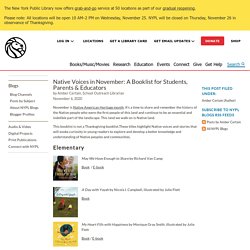
Be Thankful Without Being Hurtful. Teaching Thanksgiving Responsibly This Year I remember learning about the first Thanksgiving in school.

Half of the kids in my classroom made paper pilgrim hats.The other half made “Indian” head dresses with feathers. Our teacher gave us pumpkin pie and snacks as our “Thanksgiving feast.” We also made turkey crafts out of tracing our hands. As a fourth grader, I remember believing that the Native American and White colonist relationship consisted of peacefully gathering together to have a jolly time eating turkey and expressing their thanks. In Coversation with Patrisse Cullors. What is translanguaging? – EAL Journal. ‘Translanguaging’ – the use of different languages together – can be a powerful tool for learning … but it can also go against the grain for language teachers who are used to supporting learners to master the intricacies of a single language.
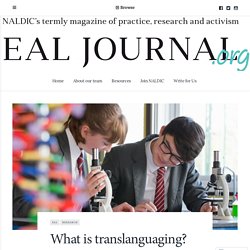
In this post, we ask what the research tells us about ‘translanguaging’ and how it can be used to support EAL learners in the classroom. Picture the scene: two students are sitting together, working intently on a handout. About Us - Kutsche Office of Local History. The Kutsche Office was established with a generous gift to the University from Grand Rapids resident and retired anthropology professor, Dr.
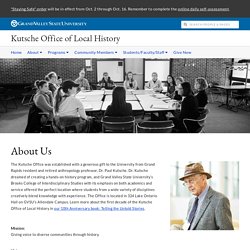
Paul Kutsche. Dr. Kutsche dreamed of creating a hands-on history program, and Grand Valley State University’s Brooks College of Interdisciplinary Studies with its emphasis on both academics and service offered the perfect location where students from a wide variety of disciplines creatively blend knowledge with experience. The Office is located in 324 Lake Ontario Hall on GVSU's Allendale Campus. Learn more about the first decade of the Kutsche Office of Local History in our 10th Anniversary book: Telling the Untold Stories.
Mission: Giving voice to diverse communities through history. Vision: The Kutsche Office of Local History will be a regional and national model for fostering intentional and deep community connections through the collection, preservation, and dissemination of the diverse histories of underrepresented populations. Voices. EJ1048612 - Supporting English and Spanish Literacy through a Family Literacy Program, School Community Journal, 2014. Family literacy studies have shown that the role of parental storybook reading has an impact on children's success in school-based literacy instruction.
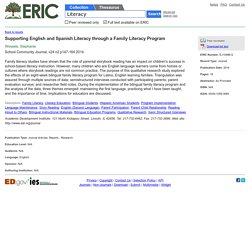
However, many children who are English language learners come from homes or cultures where storybook readings are not common practice. The purpose of this qualitative research study explored the effects of an eight-week bilingual family literacy program for Latino, English learning families. Triangulation was assured through multiple sources of data: semistructured interviews conducted with participating parents; parent evaluation surveys; and researcher field notes.
During the implementation of the bilingual family literacy program and the analysis of the data, three themes emerged: maintaining the first language, practicing what I have been taught, and the importance of time. Implications for educators are discussed. Academic Development Institute. 121 North Kickapoo Street, Lincoln, IL 62656. EJ1141857 - Developing Globally Minded, Critical Media Literacy Skills, Journal of Social Studies Education Research, 2017. The transnational movement of people and ideas continues to reshape how we imagine places and cultures.
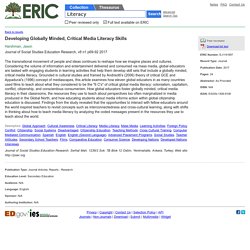
Considering the volume of information and entertainment delivered and consumed via mass media, global educators are tasked with engaging students in learning activities that help them develop skill sets that include a globally minded, critical media literacy. Grounded in cultural studies and framed by Andreotti's (2006) theory of critical GCE and Appadurai's (1996) concept of mediascapes, this article examines how eleven global educators in as many countries used films to teach about what they considered to be the "6 C's" of critical global media literacy: colonialism, capitalism, conflict, citizenship, and conscientious consumerism. Journal of Social Studies Education Research. Serhat Mah. 1238/2 Sok. 7B Blok 12 Ostim, Yenimahalle, Ankara, Turkey; Web site: Common Sense Media Resources About Race and Racism. Resource for Talking About Race & Diversity. Racial Wealth Gap Learning Simulation.
What is the Racial Wealth Gap Learning Simulation?

The simulation is an interactive tool that helps people understand the connections among racial equity, hunger, poverty, and wealth.